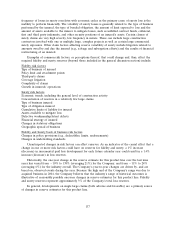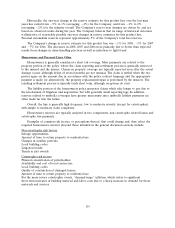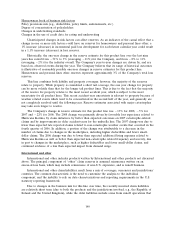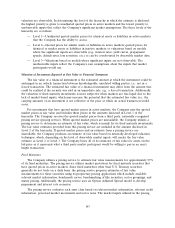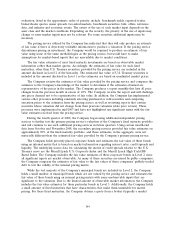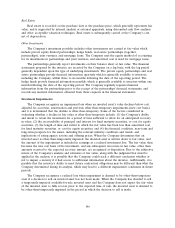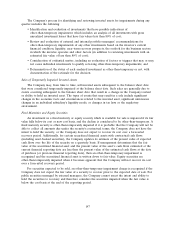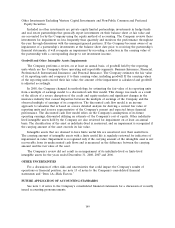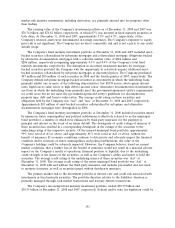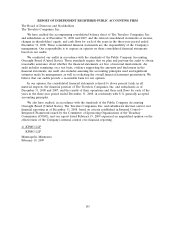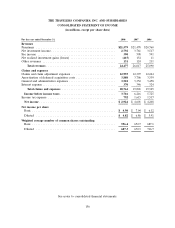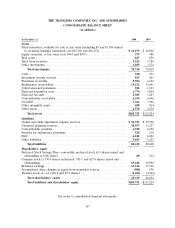Travelers 2008 Annual Report Download - page 159
Download and view the complete annual report
Please find page 159 of the 2008 Travelers annual report below. You can navigate through the pages in the report by either clicking on the pages listed below, or by using the keyword search tool below to find specific information within the annual report.The Company’s process for identifying and reviewing invested assets for impairments during any
quarter includes the following:
• Identification and evaluation of investments that have possible indications of
other-than-temporary impairment, which includes an analysis of all investments with gross
unrealized investment losses that have fair values less than 80% of cost;
• Review and evaluation of external and internal portfolio managers’ recommendations for
other-than-temporary impairments of any other investments based on the investee’s current
financial condition, liquidity, near-term recovery prospects, the outlook for the business sectors
in which the investee operates and other factors (in addition to reviewing investments with an
estimated fair value of less than 80% of cost);
• Consideration of evidential matter, including an evaluation of factors or triggers that may or may
not cause individual investments to qualify as having other-than-temporary impairments; and
• Determination of the status of each analyzed investment as other-than-temporary or not, with
documentation of the rationale for the decision.
Sales of Temporarily Impaired Invested Assets
The Company may, from time to time, sell invested assets subsequent to the balance sheet date
that were considered temporarily impaired at the balance sheet date. Such sales are generally due to
events occurring subsequent to the balance sheet date that result in a change in the Company’s intent
or ability to hold an invested asset. The types of events that may result in a sale include significant
changes in the economic facts and circumstances related to the invested asset, significant unforeseen
changes in an individual subsidiary’s liquidity needs, or changes in tax laws or the regulatory
environment.
Fixed Maturities and Equity Securities
An investment in a fixed maturity or equity security which is available for sale is impaired if its fair
value falls below its cost or new cost basis, and the decline is considered to be other-than-temporary. A
fixed maturity security is other-than-temporarily impaired if it is probable that the Company will not be
able to collect all amounts due under the security’s contractual terms, the Company does not have the
intent to hold the security, or the Company does not expect to recover its cost over a forecasted
recovery period. Additionally, for certain securitized financial assets with contractual cash flows
(including asset-backed securities), the Company updates its estimate of the present value of expected
cash flows over the life of the security on a quarterly basis. If management determines that the fair
value of the securitized financial asset and the present value of the asset’s cash flows estimated at the
current financial reporting date are less than the present value of the estimated cash flows at the date
of purchase (or previous financial reporting date), then an other-than-temporary impairment is
recognized and the securitized financial asset is written down to fair value. Equity securities are
other-than-temporarily impaired when it becomes apparent that the Company will not recover its cost
over a forecasted recovery period.
For securities expected to be sold, an other-than-temporary impairment charge is recognized if the
Company does not expect the fair value of a security to recover prior to the expected date of sale. For
public securities managed by external managers, the Company cannot assert the intent and ability to
hold the securities to recovery and therefore considers the securities impaired when the fair value is
below the cost basis at the end of the reporting period.
147


